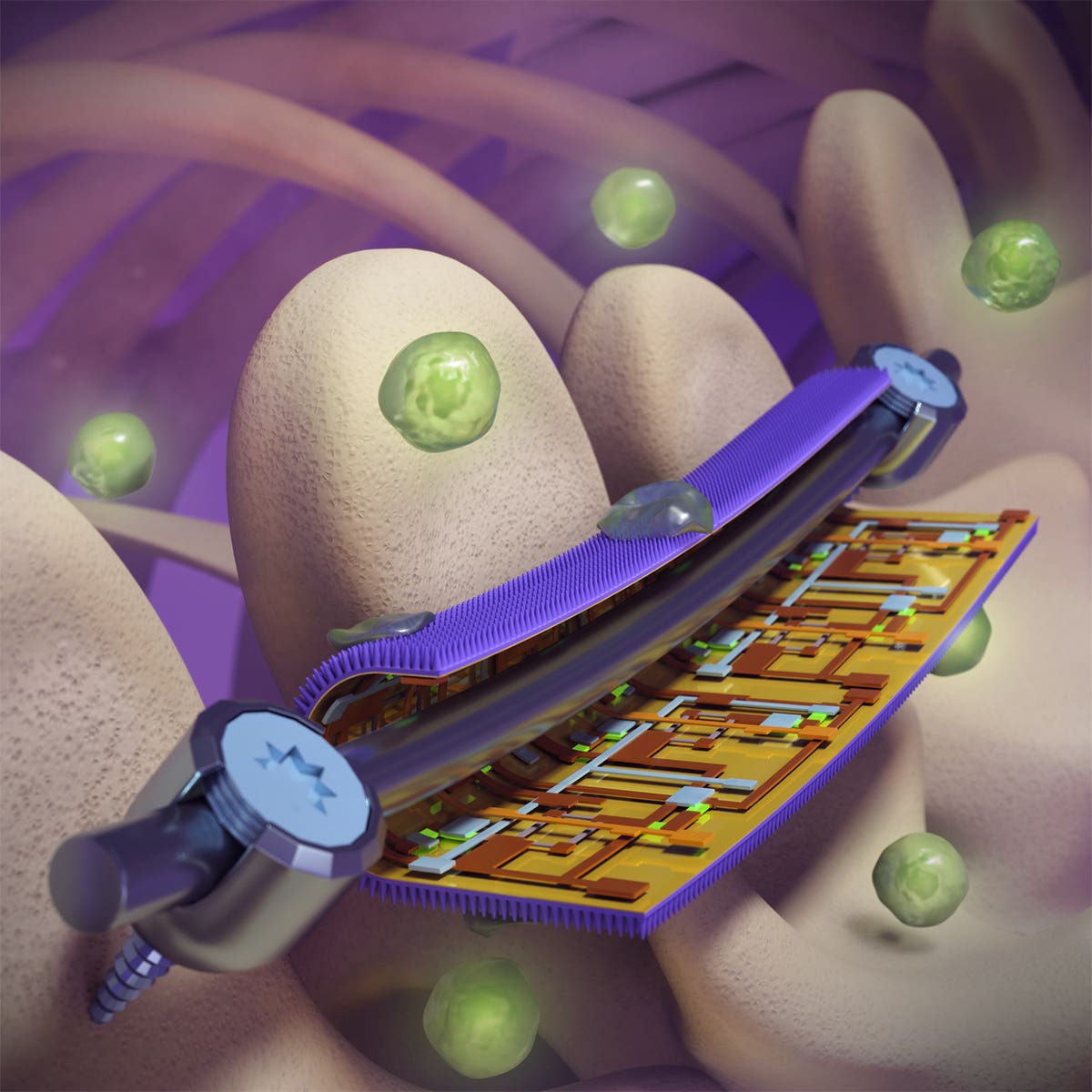Smart surgical implant coating prevents infection while providing early failure warning
Researchers have developed innovative “smart” coatings which can both detect strain on the devices and eliminate infection-causing bacteria.

[May 8, 2023: Staff Writer, The Brighter Side of News]
Smart coatings on orthopedic implants, developed at the University of Illinois Urbana-Champaign, have bacteria-killing nanopillars on one side and strain-mapping flexible electronics on the other. This could help physicians guide patient rehabilitation and repair or replace devices before they fail. (CREDIT: Beckman Imaging Technology Group)
Researchers from the University of Illinois Urbana-Champaign have developed innovative "smart" coatings for orthopedic surgical implants, which can both detect strain on the devices and eliminate infection-causing bacteria. These coatings combine flexible sensors and a nanostructured antibacterial surface inspired by the wings of dragonflies and cicadas.
Published in Science Advances, the study reveals that a multidisciplinary team of researchers discovered the coatings to be effective in preventing infections in mice and in identifying strain in commercial implants used on sheep spines. This can provide early warnings for potential implant failures or complications during the healing process.
“This is a combination of bio-inspired nanomaterial design with flexible electronics to battle a complicated, long-term biomedical problem,” said study leader Qing Cao, a U. of I. professor of materials science and engineering.
Infection and device failure present significant challenges in orthopedic implants, impacting up to 10% of patients, according to Cao. Numerous strategies have been explored to combat infection, yet each exhibits considerable drawbacks.
Related Stories:
For example, biofilms can still develop on hydrophobic surfaces, while coatings containing antibiotics or drugs are depleted within months and can harm surrounding tissue without effectively combating drug-resistant bacteria strains.
Drawing inspiration from the innate antibacterial properties of cicada and dragonfly wings, the researchers from Illinois designed a thin foil adorned with nanoscale pillars resembling those on the insects' wings. When bacteria attempt to adhere to the foil, the pillars penetrate the cell wall, effectively killing the bacterial cell.
“Using a mechanical approach to killing bacteria allowed us to bypass a lot of the problems with chemical approaches, while still giving us the flexibility needed to apply the coating to implant surfaces,” said pathobiology professor Gee Lau, a coauthor of the study.
The devices combine insect-inspired nanostructured foils with highly sensitive flexible electronics. Here the device prototypes are applied to commercially available spinal implants and displayed on a spine model. (CREDIT: Yi Zhang)
On the reverse side of the nanostructured film, where it connects with the implant device, the scientists incorporated an array of highly sensitive, flexible electronic sensors to track strain. This could enable doctors to observe the healing process of individual patients, optimize rehabilitation to reduce recovery time and minimize risks, and mend or replace devices before they reach the point of failure, according to the researchers.
The engineering team collaborated with Annette McCoy, a veterinary clinical medicine professor, to test their prototype devices. They implanted the films in live mice and observed them for any indications of infection, even when bacteria were present.
Design of the dual-functional smart-coating foil for orthopedic implants. Schematics (A) and optical image (B) showing the smart-coating foil with integrated biomimetic mechano-bactericidal and multiplexed strain-sensing functionalities for orthopedic implants. (CREDIT: Science Advances)
Additionally, they applied the coatings to commercially available spinal implants and monitored strain on the implants in sheep spines under normal load to diagnose device failure. The coatings successfully fulfilled both functions.
While the prototype electronics necessitated the use of wires, the researchers' next goal is to create wireless power and data communication interfaces for their coatings, a vital advancement for clinical use, as noted by Cao.
Researchers are also working towards developing large-scale production of the nanopillar-textured foil with bacteria-eliminating properties.
The optimum biomimetic nanopillar-array design ensuring high antimicrobial activities, structural robustness, and biocompatibility with mammalian cells. (CREDIT: Science Advances)
“These types of antibacterial coatings have a lot of potential applications, and since ours uses a mechanical mechanism, it has potential for places where chemicals or heavy metal ions – as are used in commercial antimicrobial coatings now – would be detrimental,” Cao said.
The National Science Foundation and the U.S. Congressionally Directed Medical Research Programs supported this work.
For more science and technology stories check out our New Discoveries section at The Brighter Side of News.
Note: Materials provided above by the The Brighter Side of News. Content may be edited for style and length.
Like these kind of feel good stories? Get the Brighter Side of News' newsletter.



